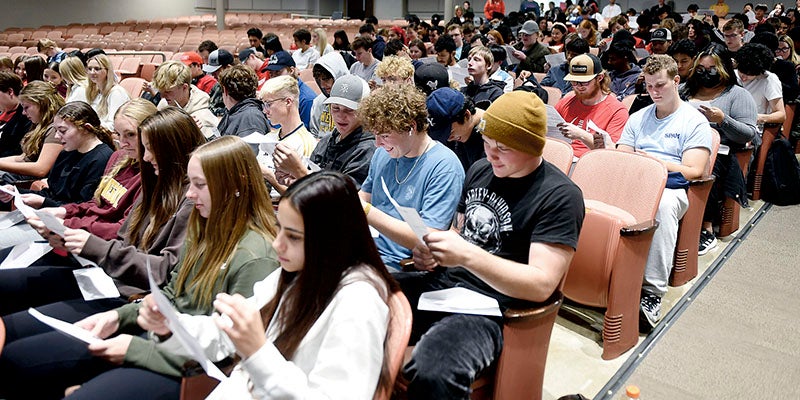Rush is on to finish $310M state Capitol renovation as reopening nears
Published 10:46 am Tuesday, August 16, 2016

- Photo provided
By David Montgomery
St. Paul Pioneer Press
ST. PAUL — Minnesota’s newly renovated Capitol will reopen to the public in January, and state leaders are hurrying to make sure it’s ready for its close-up.
The 1905 building has been closed for much of the past three years as part of a $310 million renovation project to shore it up structurally and restore its century-old aesthetics. It opens Jan. 1, in time for the 2017 legislative session. But the formal grand re-opening ceremony won’t be until fall 2017.
Even by that fall ceremony, visitors might not arrive to find a fully finished restoration.
“Everything doesn’t have to be done by either January or the grand opening,” said Paul Anderson, a retired Minnesota Supreme Court justice who co-chaired a subcommittee looking at art in the Capitol. “It’s a long-term approach or philosophy or vision that we’re adopting.”
What will be done by January
Over the past three years, construction crews have gutted the 111-year-old building. It’s received major structural and mechanical enhancements. Its exterior marble coating has been thoroughly refurbished. Historic areas inside the building, including the legislative chambers and the governor’s office, have been restored, as has the building’s antique furniture.
The renovation also has converted some previously private parts of the Capitol into about 36,000 square feet of new public space.
The final building is supposed to be safer, more efficient, more accessible and restored for generations to come.
One of the most visible parts of the Capitol, the gold-leaf “Quadriga” statue that normally adorns the front of the Capitol roof, is also supposed to be back on its perch by January — though Gov. Mark Dayton is skeptical.
The state’s Capitol Preservation Commission was presented on Monday with a $375,000 proposal to treat and refurbish damage the Quadriga has endured from the elements. The commission approved the proposal, but Dayton complained about how late it had been brought forward.
“I don’t understand why there’s this lack of urgency,” Dayton said Monday. The Quadriga is supposed to be re-installed in December — “weather permitting.”
What will be finished next year
When lawmakers, staff, reporters and the public reoccupy the Capitol in January, they’ll find some signs of ongoing work.
Some halls will bear scaffolding for ongoing decorative painting. A number of offices in the building will remain closed for ongoing millwork, flooring work, door hangings and other upgrades. Staff who are supposed to work out of these offices will continue to be based in nearby buildings.
Project overseers also expect some things in the Capitol won’t function as expected — requiring spot fixes. Department of Administration spokesman Curt Yoakum said that’s the case with any major construction project,
“There’s going to be stuff that doesn’t work that gets fixed under warranty,” said state Rep. Matt Dean, R-Dellwood, a member of the Capitol Preservation Commission. “There’s also things that just aren’t going to practically work once we start using the building.”
The state doesn’t have a budget set aside to fix those issues, but it does have a warranty that will cover the cost of any defects discovered in the first two years.
Other renovations will have to wait until spring, including final work on the Capitol roof and landscaping on the grounds.
What could take longer
Renovating a building is one thing. Deciding what pictures to hang on the walls is apparently another thing entirely.
A subcommittee dedicated to resolving this question presented its report Monday after studying it for years — and admitted that in some areas they “did not have time to develop or vote on any art alternatives.”
The restoration has created new public space where art could be hung, but no one has decided which art. The Capitol Preservation Commission discussed the issue Monday but didn’t make any decisions before it adjourned until October.
The Minnesota Historical Society, which has jurisdiction over much of the Capitol, has over 6,000 pieces of Minnesota art in storage, “but a lot of those works would not be appropriate for the Capitol,” Historical Society director and CEO D. Stephen Elliott said.
The art subcommittee recommended that this art reflect Minnesota’s whole history, not just the period through 1905 as with the building’s original art. Another recommendation was to add interpretive information to as many art objects as possible.
Overshadowing the question of what art to hang is the thornier question of what not to hang. Several historic paintings in the Capitol are controversial today because of depictions of women and Native Americans. The art subcommittee recommended moving some of these works to less prominent locations in the Capitol and adding interpretive information about their context.
—Distributed by Tribune Content Agency




